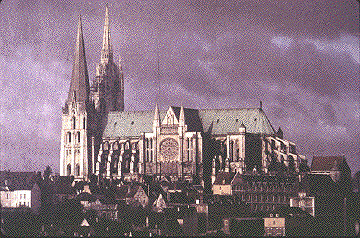October 17: Religion and the Chartres Cathedral
Consecration of Chartres Cathedral (1260)
It was on this date, October 17, 1260, that one of the finest examples of high Gothic art, Chartres Cathedral in northern France, was consecrated under King (Saint) Louis and Pope Alexander IV. It is known officially as the "Cathedral of Our Lady in Chartres," (French: Cathédrale Nôtre-Dame de Chartres) Although there would be additions after 1260, the original 13th century structure, begun in 1145 and resumed after a fire in 1194, was completed over a 26-year period.
Surely, the Chartres Cathedral is an example of the quality of art inspired by religious faith? Such a romantic notion of the Middle Ages, as often taught in high school history classes, would be true if it could be demonstrated from history that periods of undisturbed religious faith coincided with periods of great art. Even a casual observer of the period would note that of course there was great religious art in the medieval era because the Roman Catholic Church was very wealthy and therefore employed the most talented artists!
The Gothic style we see in the Chartres Cathedral was developed very slowly during two centuries from the Romanesque in north-central France. Far from a product of faith, Gothic art arose at a time when the bishoprics and abbeys were woefully corrupt. Its technical advances were developed along utilitarian, not sectarian, lines.
If faith built the cathedrals, whose faith would that be? Certainly not the many workers, for their hands only moved the materials. It must have started with the architects, but what do we really know about them? For example, the architect of the beautiful Speyer Cathedral in Germany was the Bishop of Osnabruck. He took religious orders only for the title and revenues and was described by contemporaries as "sensual and worldly." The architect at Chartres was Béranger, but little is known of his religious faith, or if he had any at all. Even the names of other architects at other cathedrals are totally unknown.
In fact, the Chartres Cathedral was constructed as a tourist trap: its very purpose was to attract pilgrims to patronize local merchants and fill church coffers with cash. Civic authorities candidly crowed that they just wanted to outshine, if not outspend, other cities. Was this religious passion, or the desire for donations?
But, then, the general piety and sobriety of the Age of Cathedrals are always overstated in popular histories. The period coincides with the notorious Age of Chivalry, one of the most egregiously licentious in European history. It is not often pointed out that the cathedrals (notably Chartres and Rheims) were used in the week after Christmas for the "Feast of Fools" and for blasphemous and indecent parodies of the Mass – often with the participation of the clergy! Pope Innocent III condemned the practice, which shows that it was taking place. The cathedrals had many nooks and crannies, perfect for furtive "assignations" or for soliciting for prostitution: in fact, in Germany, some prostitutes were called "Cathedral Girls."
Yes, there were many pious people in the Age of Cathedrals, but the general moral level would shock a rock star. The most authoritative histories of the era confirm that the artwork was inspired by an economic revival and a concentration of wealth, not a religious revival or a concentration on Christ. Does religion inspire great art? If the Cathedral at Chartres is any example, the answer is – only when the inspiration comes in the form of gold coins!
Originally published October 2003 by Ronald Bruce Meyer.



